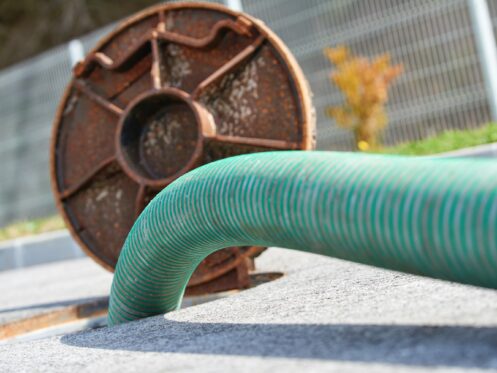Some homes in Eugene, OR are at risk of backflow. Backflow occurs when water no longer moves in a single direction through your plumbing system. Rather, it reverses its direction and contaminates your clean water supply. This can be a major health concern and lead to plumbing and appliance damage. Luckily, there are steps you can take to prevent backflow so you won’t need emergency sewer repair or other urgent services. This includes the use of backflow prevention devices.
The Reason Backflow Occurs
Backflow occurs when there is a change in pressure from a drop in supply, burst pipe, large water demand or cross-connection issues. Pressure within your pipes will become greater than the water pressure that is present in your incoming supply. This shift can occur without warning and result in a vacuum effect that draws water in the opposite direction.
Unfortunately, backflow can often occur without warning or with minimal signs. There are things that can increase your risk of backflow, such as having a sprinkler system on your property or when a fire hydrant near your home is in use by your local fire department. A break in a pipe nearby can also cause backflow that affects you and your neighbors. That’s why you often see a boil water advisory in effect when plumbing work is being done in a specific area.
The Use of Backflow Prevention Devices
Backflow prevention devices ensure that water will continue to flow in a single direction even if pressure changes in your plumbing system. Depending on your needs, our team can help you determine what kind of backflow prevention device would be best to install. We can also determine where your device should be installed on your plumbing system.
Atmospheric Vacuum Breaker Units
By introducing air into your plumbing system, an atmospheric vacuum breaker can interrupt the vacuum that is created when backflow is present. You’ll usually need this device for outdoor plumbing systems, such as hot tubs, pools and sprinklers.
Double Check Valve Assemblies
A double check valve assembly will sense when there is a drop in water pressure inside your plumbing system. We usually install these devices at a point in your plumbing system that is lower than the pressure upstream. A second valve in the device starts working if there is a failure with the first part of the system. This backflow prevention device is very effective, but it’s often used in homes that have a low risk of backflow; however, homeowners may opt for these when they want to always ensure a safe water supply.
Pressure Vacuum Breaker Devices
When backflow is a risk but not at a very high rate of pressure, a pressure vacuum breaker is a great option. This device features a spring-loaded check valve that directs water in one direction. The valve remains open while normal water flow is in motion. As soon as pressure changes are detected, an inlet valve will open and introduce air to stop the vacuum effect.
Reduced Pressure Zone Device
Homes with a high risk of backflow require a backflow prevention device that features multiple stages of support to protect against chemical contamination and pathogens. A reduced pressure zone backflow prevention device features a pressure relief valve along with two check valves.
Protecting Your Neighbors From Contamination
While a backflow prevention device is designed to protect your clean water supply, this is something that can also benefit your neighbors. Substantial amounts of backflow can contaminate the water supply in neighboring homes. This can create a liability risk that can be expensive and stressful. It’s best to invest in a backflow prevention device that benefits everyone in your immediate area.
The Integrity of Your Plumbing System
In addition to contamination concerns, backflow can also damage your plumbing system and appliances like your dishwasher or washing machine. This is caused by a change in pressure that leads to the corrosion of pipes and interior parts. You may notice that your plumbing system requires the same pipe or parts to be repaired frequently if backflow is present.
Assessing Your Risk of Backflow
Someone from our team can perform a backflow test to determine your risk of backflow. However, there are other signs you can watch out for that indicate you should schedule an appointment with our team immediately.
Spotting Changes in Water Pressure
There are a few reasons you can experience a change in water pressure, including clogs, issues with your main water supply and backflow. It’s also common for changes in water pressure to cause problems.
Water Quality Concerns
The water coming from your faucets and fixtures should be clear and free of odors or bad tastes. If you notice sediment or discoloration, this can indicate the presence of backflow contamination. This contamination can also make your water smell or taste like sulfur. Never continue using or consuming water that you suspect is contaminated. You run the risk of experiencing an infection from bacteria such as E. coli.
Odd Sounds From Pipes and Fixtures
A gurgling or whoosh sound can indicate that there has been a change in water pressure. Backflow can occur and impact the ability of your plumbing system to promote proper drainage.
Professional Backflow Inspection Services
While any home can experience backflow, we can do an inspection to determine the likelihood of this occurring. We use test cock adapters and water pressure gauges to spot this problem. Our professional plumbing service can also do a visual inspection to find any areas that may be of concern, like incorrect bends or connections.
Once you have a backflow prevention device installed, we recommend having it professionally inspected once per year. We can test these devices by creating a small change in pressure to see if your device engages. Also, professional installation is imperative to ensure you comply with local code enforcement and don’t make a potential problem worse.
Most backflow prevention devices are designed to withstand changes in pressure and exposure to water, lasting for approximately 15 to 25 years. If backflow is very common in your home, this time frame may be shorter because of frequent use of your device. It’s common for certain components of your backflow prevention device to require replacement or repairs, such as seals and O-rings.
Routine maintenance is also necessary, and this will include the removal of debris and mineral deposits. Otherwise, clogs and improper seals can prevent the proper function of your backflow prevention devices.
Does a Backflow Prevention Device Reduce Water Flow?
You shouldn’t notice any substantial change in water flow once your backflow prevention device is installed. However, there may be a slight difference. This is caused by the check valves and air gaps that are introduced to promote a slight resistance against pressure and directional changes. Substantial changes in flow may indicate a clog or damage to your backflow preventer.
Get the Pros on the Job
Pacific Plumbing & Rooter Inc is available to perform a backflow test and install backflow prevention devices in your home. We can also perform plumbing repairs and address contamination concerns. Contact Pacific Plumbing & Rooter Inc for backflow assistance in Eugene today.







